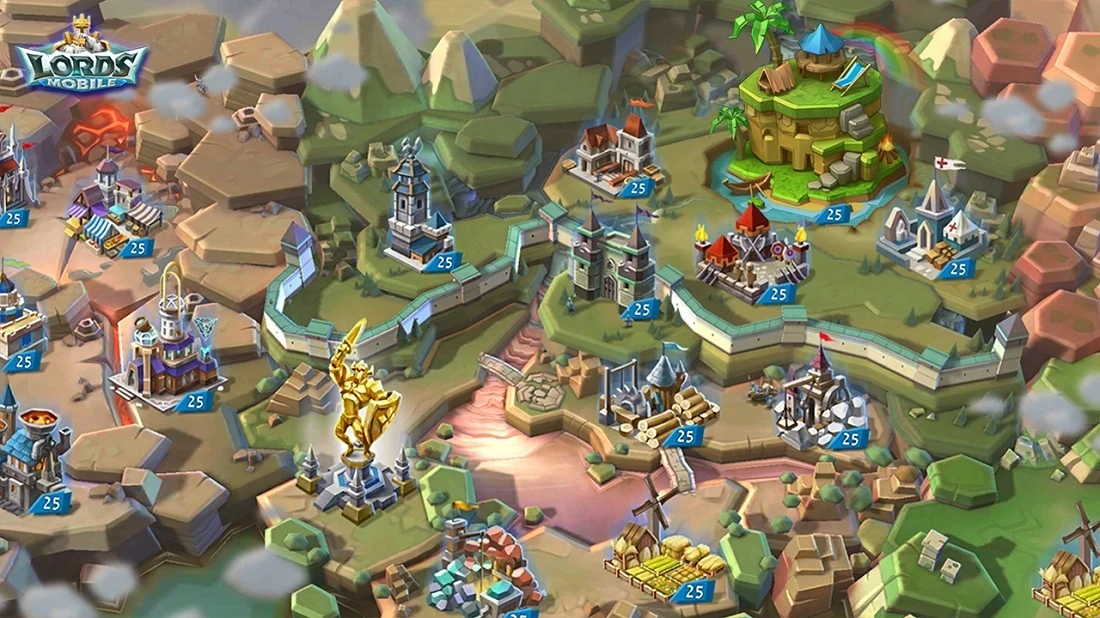Wondering who are strategy gamers?
You’re in for a treat.
In this research, we explore who is playing mobile strategy games and what motivates strategy gamers.
We also cover:
- The role of community in strategy games
- Features every successful strategy game needs to have
- Best monetization methods for strategy games
- The type of ads strategy players prefer
This information will help you improve your strategy game as well as your mobile game advertising efforts.
Let’s dive right in!
Introduction and Methodology
This research is based on data from Facebook Gaming’s report titled Genre and Great Games (with contributions from Facebook IQ and GameRefinery).
In this report, more than 13,000 mobile gamers across 11 countries were surveyed, while the focus is on 4 key markets – the United States, the United Kingdom, South Korea, and Japan.
You’ll gain insight into the state of mobile strategy games and who are strategy players.
Furthermore, you’ll understand what motivates players to get into strategy games and how well mobile games in this genre deliver on those needs.
We also explore the role of community in strategy games, the types of ads strategy gamers like to see, and what monetization models work best.
Most importantly, these insights will help you make better games and acquire more users.

The Power of Genre
Before we get into the specifics of strategy games, it’s important to understand the importance of mobile game genres to players.
The mobile game genre is the top factor that influences players to try a new game (49%). For 40% of gamers, recommendations from family and friends are important. App store reviews are a factor for 35% of players.
Another interesting thing is that each country has a different genre preference. For example, in the US, top genres are card/casino, matching puzzle, word/brain/board, and hyper-casual.
While for Japan, top genres are matching puzzle, puzzle RPG, racing, action RPG/MMORPG, and AR/Location-based.

The State of Mobile Strategy Games
There are many different sub-genres of strategy games like multiplayer battle arena, tactical battler, or 4x strategy.
1 in 4 mobile gamers play strategy games and they’re the most popular in the US and South Korea.
In the US, 14% of revenue share comes from strategy games. 15% in the UK, 8% in Japan, and 20% in South Korea.

Who is Playing Mobile Strategy Games?
In order to make an awesome strategy game and monetize it successfully, you need to have a deep understanding of your target audience.
So let’s answer this important question – who are strategy players?
In the US, UK, Japan, and South Korea, 65% to 69% strategy gamers are male. The majority of them are aged 25 to 44. From that, we can conclude that most strategy gamers are young males.
On average, they play 2 to 3 games.
The majority of strategy gamers play for a longer time (more than 30 minutes per session). They also tend to identify as gamers more than other players. Strategy players prefer online multiplayer features and value social interactions in games.
Furthermore, they like to play strategy games because completing something challenging is appealing to them and because they like to immerse themselves in another world or character.
We’ll talk more about that in the following section.
What Motivates People to Play Strategy Games?
In order to deliver exactly what strategy gamers want in a game, you need to understand what motivates them to play games in this genre.
According to the survey by Facebook Gaming, the two most important reasons why people enjoy strategy games are stress relief and feeling accomplished for completing something challenging. That’s true for all countries this report focuses on – the US, UK, South Korea, and Japan.
Other important reasons for playing mobile strategy games include:
- defeating others in competition
- passing time
- getting immersed in another world
- connecting with friends
- collecting virtual items
- being dazzled by something unique

You can see the specific percentages for each one in the provided graphs, as well as how well strategy games deliver on this.

While most strategy games are great at providing “defeating others in competition” and “passing time”, they’re not delivering on others.
For example, 55% of strategy gamers in the US want to feel accomplished for completing something challenging. However, only 43% of players feel current strategy games are providing this. The situation is very similar in Japan as well.
Furthermore, UK strategy gamers want to connect with friends, but only 37% think strategy games deliver that.
There’s also a disconnect in South Korea, where 61% play mobile strategy games to relieve stress, but only 37% of players think current games deliver that.
What Leads to High Churn Rates?
If there’s no fulfillment in these motivations to play strategy games, it will result in high churn rates i.e. a player will abandon a game.
As we have seen in the previous section, there are gaps between what players want and what they’re getting. If a game doesn’t meet their expectations, they’ll quickly become bored and uninterested.
They might move on to another strategy game, or even to another genre. For example, across all four markets (the US, UK, South Korea, and Japan), many strategy gamers also download hyper-casual and action games.
Here are the main reasons gamers stop playing a strategy game.
In the US market, 41% get bored, 29% feel they’re not making progress, and 24% abandon a game because it’s too repetitive.
35% of UK players get bored, 22% think the game is too repetitive, and 22% are irritated with ads that are too frequent.
In Japan, 49% get bored, 34% lose interest when the game is too slow, and 24% stop playing because in-app purchases are too aggressive.
38% of South Korean players get bored, 32% stop playing because a game is too repetitive, and 29% because a game is too aggressive with in-app purchases.
So the main reason why gamers abandon strategy games is that they get bored.

The Main Features a Strategy Game Needs to Have to Keep Players Engaged and Satisfied
So how to create a great mobile strategy game that users will love and keep playing?
Here are a couple of tips based on user surveys.
According to gamers, the basic features every strategy game should have:
- recurring and non-recurring live events
- collectible mechanics
- visual progression of buildings/units
- achievement system
- daily login rewards
- over 20 different permanent buildings
Now, here’s what you need to do if you want to be a real winner and have a successful strategy game.
There are 3 in-game features that the top 20% of strategy games have and this is what differentiates them from all others. According to Facebook Gaming’s data, the top 20% strategy games utilize these features significantly more.
They are special PVE modes, exclusive live event rewards, and salvage characters/items.

PVE Modes
Most strategy games focus only on competitive PvP-action. But according to gamers, they also like less competitive PvE playing as well. So having special single-player/non PvP multiplayer modes that are different from main campaigns will help you improve user retention.
A great example is the Explorer Trail in State of Survival.
Exclusive Live Event Rewards
A great way of giving players a sense of accomplishment and satisfaction is to allow them to participate in exclusive live events. And reward successful players with valuable items like in-game currency, items, buildings, or special titles.
A good example of that is Event Heroes in Lords Mobile.
Salvage Characters/Items
Many top strategy games have salvage mechanics that allow players to scrap obsolete items like weapons or armor to get materials to craft new items. That way, the value of in-app purchases and other rewards is increased.
A great example of that is scrapping ships in Star Trek Fleet Command.

The Role of Community in Strategy Games
As it was already mentioned, the social aspect of strategy games is really important to players. As much as 75% of strategy gamers in the US and South Korea regularly engage in social activities like chatting with other players.
US strategy gamers also like to compare scores with other players regularly.
66% of players in Japan and 52% of players in the US frequent online gaming forums and communities, primarily to learn how to get better at the game.
What developers need to focus on is enhancing the sense of community in strategy games by allowing players to be social.

Information Strategy Gamers Want to Receive from Developers
Here’s what developers can do to utilize the power of gaming communities.
94% of UK gamers and 91% of US gamers are into receiving messages from developers.
Here’s what type of information they want to receive.
Across all markets, tips, tricks & strategies, and upcoming in-game events are the number 1 information gamers want to receive.
Players also like to receive information about upcoming updates & content releases. Questions & answers, and the ability to influence/provide feedback on the game’s design is also important to players.

Community Features a Successful Strategy Game Needs to Have
Here are the basic features a strategy game should have to enhance a sense of community:
- special benefits from communal activities or PvP
- ability to see other players’ progression
- high score lists/leaderboards
- chat/messaging
- send/ask help
- asynchronous PvP
- guild mechanics
However, if you want to take your strategy game to the next level, you also need to include these features – guild wars & competitions, co-op tasks, and donating items/resources.
Facebook Gaming’s research shows that the top 20% of strategy games utilize these features significantly more than other games.

Guild Wars & Competitions
Research shows that the most successful mobile strategy games have regular guild wars and competitions, especially in 4X and Build & Battle sub-genres.
What’s important is that these features appeal to higher tier gamers who are usually the biggest spenders.
A great example of this is Osiris League in Rise of Kingdoms.
Co-op Tasks
There’s nothing more social than being able to complete challenges with your friends. That’s why co-op tasks are popular across the board.
A good example of this is Armadas in Star Trek Fleet Command.
Donating Items/Resources
Another great way of enhancing a sense of community is allowing players to donate items or resources. This feature is available in top strategy games.
A great trick for boosting in-app purchases while nurturing a sense of community is to give extra rewards to players who purchase items for their team.
A great example of this feature is Alliance Rewards in Star Trek Fleet Command.
Best Monetization Models for Strategy Games
Wondering how to monetize a mobile strategy game?
Here’s everything you need to know.

In-app Purchases in Strategy Games
Across all markets (US, UK, Japan, and South Korea), mobile strategy games are among the top three genres when it comes to in-app purchases.
South Korean strategy players make the most in-app purchases (9.6%). Strategy players in Japan are in second – 7.2% make a purchase.
Here are the most important preferences you need to keep in mind when setting up in-app purchases in a strategy game.
Across all four markets, but particularly in Japan, players prefer direct in-app purchases as opposed to ones that have a random element e.g. loot boxes.
Furthermore, the majority of strategy players don’t like a play-to-win model i.e. in-app purchases that include items help you win. Most think in-app purchases should be limited to items that don’t help you win.

How to Incorporate Ads Into Strategy Games?
While in-app purchases can be a good way of monetizing a strategy game, you shouldn’t rely solely on this model.
Here’s the thing.
In-app purchases are risky and can sometimes be a detriment. 1 in 5 players in the four markets this research is focused on say they have stopped playing a strategy game because in-app purchases were too aggressive.
That’s a common issue with in-app purchases because developers are trying to monetize their game, but sometimes go overboard. That results in a loss of players, which is the worst thing that can happen.
For that reason, it is recommended that developers go with a mixed monetization strategy that includes both in-app purchases and in-app ads.
Here’s what strategy gamers think about this.
85% of players in Japan are open to in-app ads, 84% in South Korea, 72% in the US, and 64% in the UK. So the consensus is that strategy gamers are okay with seeing ads.
Furthermore, the number of mobile games that use ads as a monetization method is on the rise. According to App Annie, 89% of most downloaded games have an SDK.
Out of those games, casual games had the most downloads. However, core genres have the biggest share of time spent in games globally (76%). Out of core genres, strategy games take the lead with 29%.
The key to successfully monetize a strategy game by implementing ads is to consider user preferences. That way, developers can make sure the user experience is satisfactory.
Most strategy gamers prefer less frequent ad breaks with longer ads, as opposed to shorter, more frequent ads. Half of Japanese strategy players would like to see one 30-second ad in 10 minutes of gameplay.
Users also respond well to rewarded video – it is a great method of incentivizing players to watch ads.
61% of strategy players from South Korea say they prefer rewarded ads over other ad formats.

Key Monetization Features a Successful Strategy Game Needs to Have
Compared to other genres, strategy games usually have high LTV (player lifetime value) and RPI (revenue per install).
That’s due to different monetization features as well as the competitive nature of these games. For that reason, developers should be smart about how they monetize their strategy game.
Let’s start with basic monetization features every strategy game should have.
According to players in four different markets (US, UK, South Korea, and Japan), focus on these monetization features:
- Consumable boosts to purchase
- Crafting/ingredient items to purchase
- Limited time IAP bundle offers
- Skipping waiting times with money
- Shop with gachas/loot boxes
- VIP system
So the basic features should include an array of different game items to purchase that are either consumable, can be used as resources, or for construction. Limited time offers and bundles are also popular with players because they’re usually a good value for money.

Now, if you want to take a strategy game to the next level, you must include the following monetization features:
- Battle pass plan
- Characters to purchase
- Gear to purchase
However, all of them are underutilized. 49% of players would like a battle pass plan but is available in only 21% of strategy games.
Furthermore, as much as 92% of players want to purchase characters, but only 69% of strategy games have that option. Finally, 71% of players want to purchase gear, but that’s available as an in-app purchase in 52% of strategy games.
Here’s an explanation of these features and tips on how to implement them in strategy games.
Battle Pass System
Battle pass system is a type of monetization strategy that gives players additional game content. It is used for many different genres, but it’s particularly effective for strategy games.
Most commonly, it’s a tiered system where users are rewarded for playing or completing a challenge and can unlock content.
Usually, we’re talking about content that doesn’t affect the core game i.e. different skins, weapons customizations, etc.
What’s great about a battle pass system is that it encourages strategy gamers to play more and keeps them interested. So not only is it a great monetization method, but it also improves metrics like engagement and user retention.
A great example of a battle pass system in strategy games is Lucerne Scrolls in Rise of Kingdoms. It’s a series of missions that offer players rewards.
Here’s how it works.
There are two different payment methods – Ancestor’s Legacy ($5) and Divine Inheritance ($19.99). The former allows players to unlock extra rewards as they complete levels. The latter quickly unlocks 10 levels and gives players 50% more clues.
Characters to Purchase
Considering many mobile strategy games have some RPG features, allowing players to purchase characters and customize them is a great idea.
This adds another layer to strategy games as well as encourages in-app purchases. It’s a win-win situation.
A good example of this is heroes in Brutal Age.
Gear to Purchase
To have a successful mobile strategy game, it’s also a good idea to offer gear to purchase. Better gear equals more power in the game, which is what players like.
This accomplishes a couple of different things.
It adds depth to the game and makes it more interesting. But it also gives developers more opportunities to boost in-app purchases because these items are valuable to players.

Ad Preferences – What Type of Ads Strategy Gamers Respond to?
Now, let’s talk about user acquisition and advertising strategies you need to use to attract strategy players.
More than 60% of users in the US, UK, South Korea, and Japan are interested in downloading and learning a new game if an advertisement makes it look fun.
This tells you that advertising can be very effective, but you need to know what you’re doing.
The ad format that is the most effective for advertising a strategy game is video. What’s great about video ads is that they’re short, visually appealing, and if done well, can convert users instantly.
Since strategy games are usually more complex than, for example, casual games, it might be beneficial to create explainer videos.
That type of video is usually slightly longer than most video ads (can go up to 90 seconds) and contain more information.
But what should you include in video ads?
Here’s what strategy gamers have to say about that.
User Ad Preferences in the US
In the US, 47% of users think ads should showcase the main gameplay, 39% think they should showcase the characters/story, and 37% think ads should showcase the progression of characters/universe.
45% of US users like a challenging tone in the ad, 44% want to see something exciting/adrenaline pumping, and 38% like a humorous tone.
User Ad Preferences in the UK
59% of UK strategy gamers want to see gameplay in ads, 39% want to see characters or main story, and 30% are interested in observing the game’s art style.
Furthermore, 43% of UK players want to get a sense of challenge, 44% want excitement and 38% like funny ads.
User Ad Preferences in Japan
For 69% Japanese players, the characters and the story are the most important element of an ad. 64% like when ads showcase the main gameplay and 28% like when control mechanics are presented.
Moreover, 57% of strategy gamers in Japan respond to a funny/humorous tone in ads. 47% like exciting ads, while 29% like relaxing and tranquil ads, which is quite surprising.
User Ad Preferences in South Korea
South Korean players have similar preferences to US and UK players. 52% want to see main gameplay, 39% the characters/story, and 39% progression of characters/universe.
46% want to see something exciting, 41% want to see something challenging, and 33% respond best to a proud/inspiring tone.
What we can conclude from that is that most strategy gamers want to see actual gameplay in ads. The interesting thing is that advertisers often go the other way and showcase puzzles and other content that’s not even in the game, instead of gameplay.
Besides gameplay, showcasing the story, characters, universe and its evolution is also very important for strategy gamers. This is what makes them interested in a new game.

How to Bring Players Back?
While attracting new players is important, retaining them is crucial for the success of any strategy game.
What often happens with mobile strategy games is that players become inactive or even worse – delete the game.
But all is not lost if something like that were to happen. There are different strategies you can utilize to bring players back.
As much as 90% of players in the US and UK say they are open to the idea of getting back to a game after not playing for a month.
Some are even open to re-downloading the game.
Here’s how you can influence strategy gamers to come back.
In both the US and UK, the three most important reasons why a player would come back are hearing about new content or available updates, getting a reward for coming back, and someone online telling them to play the game with them.
In Japan, 36% say they would come back if they hear about new content and 21% would return if someone brings up the game in an in-person conversation. 19% of Japanese strategy players would get back to playing if get a reward.
For South Korean strategy players, a reward for coming back is the most important (40%). 37% think hearing about new content or updates is a good reason to come back and 24% would return to a game if someone online invites them to play it.
User Retention Statistics for Strategy Games
To finish off, let’s look at day 1, day 7, and day 28 user retention statistics for strategy games.
According to GameAnalytics, for most genres, 35% of more day 1 user retention is considered good. Anything below 30% needs improvement.
Average strategy games retain almost 31% of users after day 1 while top-performing strategy games retain up to 38% of users, which is really good.
While all mid-core genres have a good day 7 user retention, strategy games are in the lead.
Average strategy games retain 9% of users after a week, while top strategy games retain more than 12%.
Naturally, day 28 user retention is lower than day 1 and day 7 – it’s not easy to retain players after one month.
However, strategy games have decent day 28 retention (more than 3% for average and almost 6% for top strategy games). In fact, strategy games have the best day 28 user retention out of all mid-core genres.
To Sum Up
Creating a successful strategy game and acquiring a large number of high-quality users is not an easy task. Many games fail spectacularly. That’s because many developers and game publishers rely on guesswork.
In order to avoid going down in flames, you need to base all of your strategies on data, like the one we revealed in this article.
If you consider these findings, creating a top-notch strategy game will become much easier. Now you know exactly who strategy gamers are and what they like.
However, if you still need some help with getting your strategy games to the top charts, don’t hesitate to contact us. We specialize in mobile game marketing and are happy to take a look at your game!
For more market research on mobile games, subscribe to our newsletter!







Comments